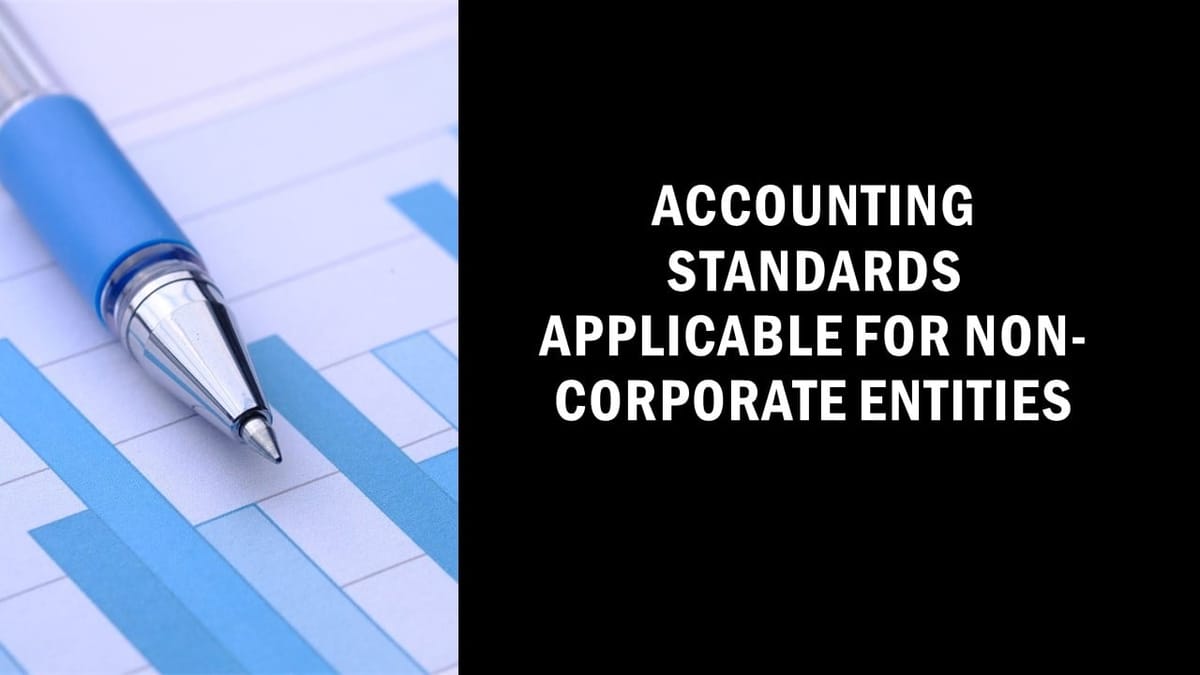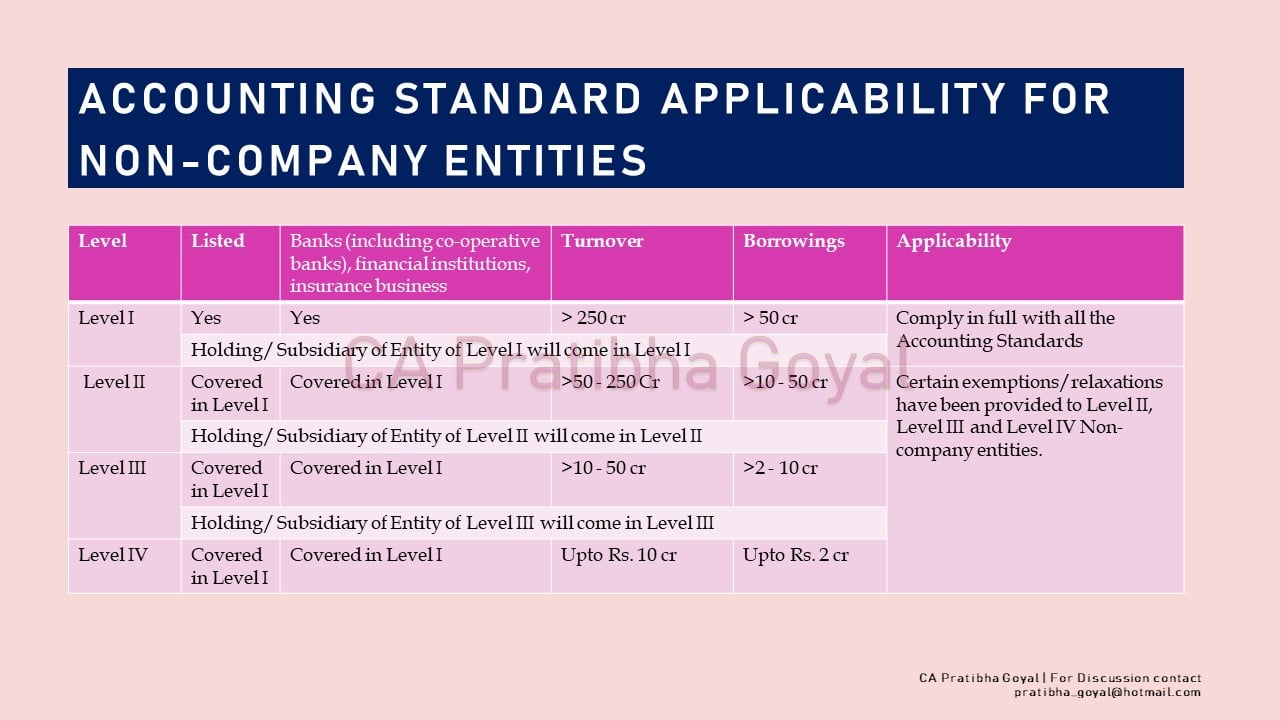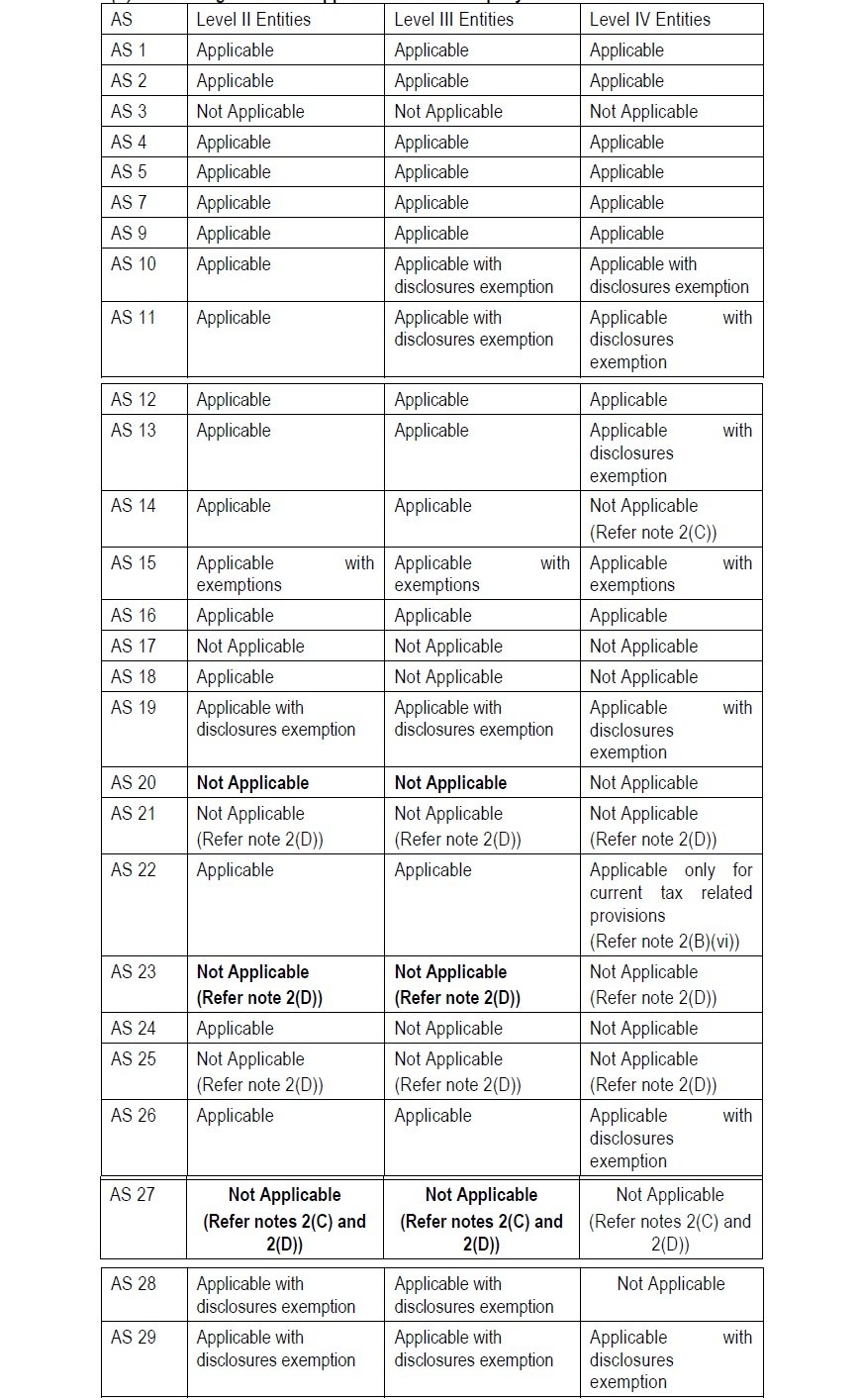CA Pratibha Goyal | Sep 1, 2023 |

Accounting Standards Applicable for Non-Corporate Entities
In this article, we will discuss about the Accounting Standards (AS) Applicable for Non-Corporate Entities. The Criteria for classification of Non-company Entities as decided by the Institute of Chartered Accountants of India (ICAI) is as follows:

Additional requirements:
(1) An MSME which avails the exemptions or relaxations given to it shall disclose (by way of a note to its financial statements) the fact that it is an MSME, the Level of MSME and that it has complied with the Accounting Standards insofar as they are applicable to entities falling in Level II or Level III or Level IV, as the case may be.
(2) Where an entity, being covered in Level II or Level III or Level IV, had qualified for any exemption or relaxation previously but no longer qualifies for the relevant exemption or relaxation in the current accounting period, the relevant standards or requirements become applicable from the current period and the figures for the corresponding period of the previous accounting period need not be revised merely by reason of its having ceased to be covered in Level II or Level III or Level IV, as the case may be. The fact that the entity was covered in Level II or Level III or Level IV, as the case may be, in the previous period and it had availed of the exemptions or relaxations available to that Level of entities shall be disclosed in the notes to the financial statements. The fact that previous period figures have not been revised shall also be disclosed in the notes to the financial statements.
(3) Where an entity has been covered in Level I and subsequently, ceases to be so covered and gets covered in Level II or Level III or Level IV, the entity will not qualify for exemption/relaxation available to that Level, until the entity ceases to be covered in Level I for two consecutive years. Similar is the case in respect of an entity, which has been covered in Level II or Level III and subsequently, gets covered under Level III or Level IV.
(4) If an entity covered in Level II or Level III or Level IV opts not to avail of the exemptions or relaxations available to that Level of entities in respect of any but not
The Accounting Standards issued by ICAI are:
AS 1 Disclosure of Accounting Policies
AS 2 Valuation of Inventories
AS 3 Cash Flow Statements
AS 4 Contingencies and Events Occurring After the Balance Sheet Date
AS 5 Net Profit or Loss for the Period, Prior Period Items and Changes in Accounting Policies
AS 7 Construction Contracts
AS 9 Revenue Recognition
AS 10 Property, Plant and Equipment
AS 11 The Effects of Changes in Foreign Exchange Rates
AS 12 Accounting for Government Grants
AS 13 Accounting for Investments
AS 14 Accounting for Amalgamations
AS 15 Employee Benefits
AS 16 Borrowing Costs
AS 17 Segment Reporting
AS 18 Related Party Disclosures
AS 19 Leases
AS 20 Earnings Per Share
AS 21 Consolidated Financial Statements
AS 22 Accounting for Taxes on Income
AS 23 Accounting for Investments in Associates in Consolidated Financial Statements
AS 24 Discontinuing Operations
AS 25 Interim Financial Reporting
AS 26 Intangible Assets
AS 27 Financial Reporting of Interests in Joint Ventures
AS 28 Impairment of Assets
AS 29 Provisions, Contingent Liabilities and Contingent Assets
Level I entities are required to comply in full with all the Accounting Standards.
(2) Applicability of the Accounting Standards and exemptions/relaxations for Level II, Level III, and Level IV Non-company entities
(A) Accounting Standards applicable to Non-company entities

(B) Accounting Standards in respect of which relaxations/exemptions from certain requirements have been given to Level II, Level III and Level IV Non-company entities:
(i) Accounting Standard (AS) 10, Property, Plant and Equipment
Paragraph 87 relating to encouraged disclosures is not applicable to Level III and Level IV Non-company entities.
(ii) AS 11, The Effects of Changes in Foreign Exchange Rates (revised 2018)
Paragraph 44 relating to encouraged disclosures is not applicable to Level III and Level IV Non-company entities.
(iii) AS 13, Accounting for Investments
Paragraph 35(f) relating to disclosures is not applicable to Level IV Non-company entities.
(iv) Accounting Standard (AS) 15, Employee Benefits (revised 2005)
(1) Level II and Level III Non-company entities whose average number of persons employed during the year is 50 or more are exempted from the applicability of the following paragraphs:
(a) paragraphs 11 to 16 of the standard to the extent they deal with recognition and measurement of short-term accumulating compensated absences which are non-vesting (i.e., short-term accumulating compensated absences in respect of which employees are not entitled to cash payment for unused entitlement on leaving);
(b) paragraphs 46 and 139 of the Standard which deal with discounting of amounts that fall due more than 12 months after the balance sheet date;
(c) recognition and measurement principles laid down in paragraphs 50 to 116 and presentation and disclosure requirements laid down in paragraphs 117 to 123 of the Standard in respect of accounting for defined benefit plans. However, such entities should actuarially determine and provide for the accrued liability in respect of defined benefit plans by using the Projected Unit Credit Method and the discount rate used should be determined by reference to market yields at the balance sheet date on government bonds as per paragraph 78 of the Standard. Such entities should disclose actuarial assumptions as per paragraph 120(l) of the Standard; and
(d) recognition and measurement principles laid down in paragraphs 129 to 131 of the Standard in respect of accounting for other long-term employee benefits. However, such entities should actuarially determine and provide for the accrued liability in respect of other long-term employee benefits by using the Projected Unit Credit Method and the discount rate used should be determined by reference to market yields at the balance sheet date on government bonds as per paragraph 78 of the Standard.
(2) Level II and Level III Non-company entities whose average number of persons employed during the year is less than 50 and Level IV Non-company entities irrespective of number of employees are exempted from the applicability of the following paragraphs:
(a) paragraphs 11 to 16 of the standard to the extent they deal with recognition and measurement of short-term accumulating compensated absences which are non-vesting (i.e., short-term accumulating compensated absences in respect of which employees are not entitled to cash payment for unused entitlement on leaving);
(b) paragraphs 46 and 139 of the Standard which deal with discounting of amounts that fall due more than 12 months after the balance sheet date;
(c) recognition and measurement principles laid down in paragraphs 50 to 116 and presentation and disclosure requirements laid down in paragraphs 117 to 123 of the Standard in respect of accounting for defined benefit plans. However, such entities may calculate and account for the accrued liability under the defined benefit plans by reference to some other rational method, e.g., a method based on the assumption that such benefits are payable to all employees at the end of the accounting year; and
(d) recognition and measurement principles laid down in paragraphs 129 to 131 of the Standard in respect of accounting for other long-term employee benefits. Such entities may calculate and account for the accrued liability under the other long-term employee benefits by reference to some other rational method, e.g., a method based on the assumption that such benefits are payable to all employees at the end of the accounting year.
(v) AS 19, Leases
(a) Paragraphs 22 (c),(e) and (f); 25 (a), (b) and (e); 37 (a) and (f); and 46 (b) and (d) relating to disclosures are not applicable to Level II Non-company entities.
(b) Paragraphs 22 (c),(e) and (f); 25 (a), (b) and (e); 37 (a), (f) and (g); and 46 (b), (d) and (e) relating to disclosures are not applicable to Level III Non- company entities.
(c) Paragraphs 22 (c),(e) and (f); 25 (a), (b) and (e); 37 (a), (f) and (g); 38; and 46 (b), (d) and (e) relating to disclosures are not applicable to Level IV Non-company entities.
(vi) AS 22, Accounting for Taxes on Income
(a) Level IV Non-company entities shall apply the requirements of AS 22, Accounting for Taxes on Income, for Current tax defined in paragraph 4.4 of AS 22, with recognition as per paragraph 9, measurement as per paragraph 20 of AS 22, and presentation and disclosure as per paragraphs 27-28 of AS 22.
(b) Transitional requirements
On the first occasion when a Non-company entity gets classified as Level IV entity, the accumulated deferred tax asset/liability appearing in the financial statements of immediate previous accounting period, shall be adjusted against the opening revenue reserves.
(vii) AS 26, Intangible Assets
Paragraphs 90(d)(iii); 90(d)(iv) and 98 relating to disclosures are not applicable to Level IV Non-company entities.
(viii) AS 28, Impairment of Assets
(a) Level II and Level III Non-company entities are allowed to measure the value in use on the basis of reasonable estimates thereof instead of
computing the value in use by the present value technique. Consequently, if Level II or Level III Non-Company Entity chooses to measure the value in use by not using the present value technique, the relevant provisions of AS 28, such as discount rate etc., would not be applicable to such an entity. Further, such an entity need not disclose the information required by paragraph 121(g) of the Standard.
(b) Also, paragraphs 121(c)(ii); 121(d)(i); 121(d)(ii) and 123 relating to disclosures are not applicable to Level III Non-company entities.
(ix) AS 29, Provisions, Contingent Liabilities and Contingent Assets (revised 2016)
Paragraphs 66 and 67 relating to disclosures are not applicable to Level II, Level III and Level IV Non-company entities.
(A) In case of Level IV Non-company entities, generally there are no such transactions that are covered under AS 14, Accounting for Amalgamations, or jointly controlled operations or jointly controlled assets covered under AS 27, Financial Reporting of Interests in Joint Ventures. Therefore, these standards are not applicable to Level IV Non-company entities. However, if there are any such transactions, these entities shall apply the requirements of the relevant standard.
AS 21, Consolidated Financial Statements, AS 23, Accounting for Investments in Associates in Consolidated Financial Statements, AS 27, Financial Reporting of Interests in Joint Ventures (to the extent of requirements relating to Consolidated Financial Statements), and AS 25, Interim Financial Reporting, do not require a Non-company entity to present consolidated financial statements and interim financial report, respectively. Relevant AS is applicable only if a Non-company entity is required or elects to prepare and present consolidated financial statements or interim financial report.
Source: ICAI Technical Guide on Financial Statements of Non-Corporate Entities
In case of any Doubt regarding Membership you can mail us at [email protected]
Join Studycafe's WhatsApp Group or Telegram Channel for Latest Updates on Government Job, Sarkari Naukri, Private Jobs, Income Tax, GST, Companies Act, Judgements and CA, CS, ICWA, and MUCH MORE!"